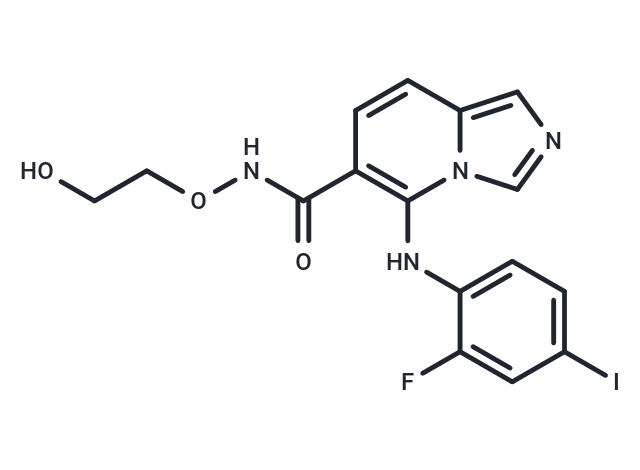Shopping Cart
- Remove All
 Your shopping cart is currently empty
Your shopping cart is currently empty

GDC-0623 (RG 7421) is a potent, ATP-uncompetitive MEK1 inhibitor with a Ki of 0.13 nM, currently in Phase 1.

| Pack Size | Price | Availability | Quantity |
|---|---|---|---|
| 1 mg | $48 | In Stock | |
| 2 mg | $67 | In Stock | |
| 5 mg | $122 | In Stock | |
| 10 mg | $197 | In Stock | |
| 25 mg | $295 | In Stock | |
| 50 mg | $388 | In Stock | |
| 100 mg | $645 | In Stock | |
| 1 mL x 10 mM (in DMSO) | $122 | In Stock |
| Description | GDC-0623 (RG 7421) is a potent, ATP-uncompetitive MEK1 inhibitor with a Ki of 0.13 nM, currently in Phase 1. |
| Targets&IC50 | MEK1:0.13 nM(ki) |
| Alias | RG 7421, MEK inhibitor 1, GDC0623, G-868 |
| Molecular Weight | 456.21 |
| Formula | C16H14FIN4O3 |
| Cas No. | 1168091-68-6 |
| Smiles | OCCONC(=O)c1ccc2cncn2c1Nc1ccc(I)cc1F |
| Relative Density. | 1.81 g/cm3 (Predicted) |
| Storage | Powder: -20°C for 3 years | In solvent: -80°C for 1 year | Shipping with blue ice. | ||||||||||||||||||||||||||||||||||||||||
| Solubility Information | H2O: < 1 mg/mL (insoluble or slightly soluble) Ethanol: 5 mg/mL (11 mM) DMSO: 91 mg/mL (198.82 mM), Heating is recommended. | ||||||||||||||||||||||||||||||||||||||||
Solution Preparation Table | |||||||||||||||||||||||||||||||||||||||||
Ethanol/DMSO
DMSO
| |||||||||||||||||||||||||||||||||||||||||

Copyright © 2015-2024 TargetMol Chemicals Inc. All Rights Reserved.